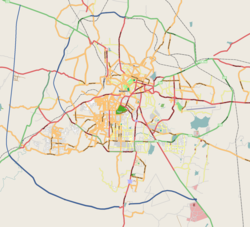Ulsoor
Halasuru Ulsoor | |
|---|---|
neighbourhood | |
| Coordinates: 12°58′N 77°38′E / 12.97°N 77.63°E | |
| Country | India |
| State | Karnataka |
| Metro | Bangalore |
| Languages | |
| • Official | Kannada |
| • Spoken | Kannada, Tamil, Telugu, Urdu, Hindi and English |
| Time zone | UTC+5:30 (IST) |
| PIN | 560008 |
| Vehicle registration | KA-03 |




Halasuru, known as Ulsoor during the British Rule, is one of the oldest neighbourhoods in the city of Bengaluru. It is in central Bengaluru, and begins near the eastern terminus of Mahatma Gandhi Raste. It is renowned for its numerous temples and market.
History and name
The village of Bangalore is said to have been gifted to Kempe Gowda I (1513–1569) by the Vijayanagara emperors. The Halasuru Lake was built by his successor, Kempe Gowda II, and is the only surviving tank built by the Gowda kings in Bangalore.[3] The first British military station was established in Halasuru in 1807.[4]
There used to be a jackfruit orchard near the Halasuru Lake, and the Kannada name for jackfruit being 'Halasina Hannu', the area came to be known as Halasuru. During the British colonial rule, the name was corrupted to Ulsoor.[citation needed]
Location in Context
Bengaluru Metro Rail
There are two Namma Metro Rail stations[5] in Halasuru:
- Halasuru (on Old Madras Road, at the end closer to CMH Road)
- Trinity (at Trinity Circle)
See also
References
- ^ "Native Girls School and Preaching-Room, Alasoor, Bangalore - Bangalore Cantonment, 8 July 1865". Wesleyan Juvenile Offering. XXII. London: Wesleyan Mission House: 43–46. December 1865. Retrieved 10 November 2015.
- ^ "A Street Scene in India, Outside the Wesleyan Girls School, Bangalore". The Wesleyan Juvenile Offering: A Miscellany of Missionary Information for Young Persons. New III. Wesleyan Missionary Society: 7. January 1869. Retrieved 24 February 2016.
- ^ "Halasuru Lake".
- ^ "The birth of a cosmopolitan city"[usurped] The Hindu. 22 Mar. 2005
- ^ "Bangalore Metro: Route Map". Retrieved 24 July 2012.

